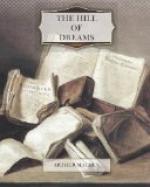And all above it was most curiously and gloriously
wrought with thorowgh carved work; in the highest
place was the Holy Roode with Christ upon the Cross
having Marie on the one syde and John on the other.
And below were six splendent and glisteringe archaungels
tha bore up the roode, and beneath them in their stories
were the most fair and noble images of the xii Apostles
and of divers other Saints and Martirs. And in
the lowest storie there was a marvelous imagerie of
divers Beasts, such as oxen and horses and swine,
and little dogs and peacocks, all done in the finest
and most curious wise, so that they all seemed as they
were caught in a Wood of Thorns, the which is their
torment of this life. And here once in the year
was a marvelous solemn service, when the parson of
Caermaen came out with the singers and all the people,
singing the psalm
Benedicite omnia opera as
they passed along the road in their procession.
And when they stood at the roode the priest did there
his service, making certain prayers for the beasts,
and then he went up to the first pace and preached
a sermon to the people, shewing them that as our lord
Jhu dyed upon the Tree of his deare mercy for us, so
we too owe mercy to the beasts his Creatures, for
that they are all his poor lieges and silly servants.
And that like as the Holy Aungells do atheir suit to
him on high, and the Blessed xii Apostles and the Martirs,
and all the Blissful Saints served him aforetime on
earth and now praise him in heaven, so also do the
beasts serve him, though they be in torment of life
and below men. For their spirit goeth downward,
as Holy Writ teacheth us.”
It was a quaint old record, a curious relic of what
the modern inhabitants of Caermaen called the Dark
Ages. A few of the stones that had formed the
base of the cross still remained in position, grey
with age, blotched with black lichen and green moss.
The remainder of the ramous rood had been used to
mend the roads, to built pigsties and domestic offices;
it had turned Protestant, in fact. Indeed, if
it had remained, the parson of Caermaen would have
had no time for the service; the coffee-stall, the
Portuguese Missions, the Society for the Conversion
of the Jews, and important social duties took up all
his leisure. Besides, he thought the whole ceremony
unscriptural.
Lucian passed on his way, wondering at the strange
contrasts of the Middle Ages. How was it that
people who could devise so beautiful a service believed
in witchcraft, demoniacal possession and obsession,
in the incubus and succubus, and in the Sabbath an
in many other horrible absurdities? It seemed
astonishing that anybody could even pretend to credit
such monstrous tales, but there could be no doubt that
the dread of old women who rode on broomsticks and
liked black cats was once a very genuine terror.




